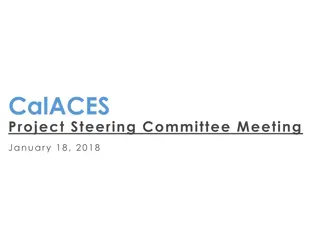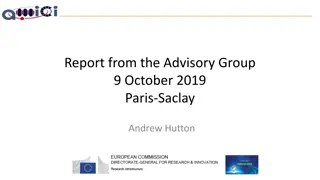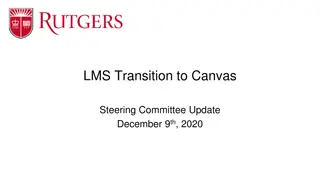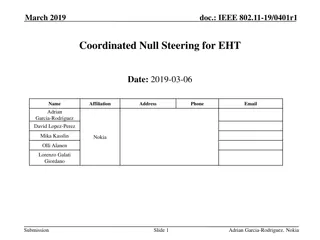LMS Transition to Canvas Steering Committee Meeting Overview
Discuss and approve new migration process for transitioning to Canvas, review migration plan and timeline, introduce K-16 Solutions Migration Tool for automated migration, update on manual and K-16 migration processes, proposed migration plan and timeline spanning Fall 2020 to Spring 2022, and outline next steps for the migration project.
Download Presentation

Please find below an Image/Link to download the presentation.
The content on the website is provided AS IS for your information and personal use only. It may not be sold, licensed, or shared on other websites without obtaining consent from the author.If you encounter any issues during the download, it is possible that the publisher has removed the file from their server.
You are allowed to download the files provided on this website for personal or commercial use, subject to the condition that they are used lawfully. All files are the property of their respective owners.
The content on the website is provided AS IS for your information and personal use only. It may not be sold, licensed, or shared on other websites without obtaining consent from the author.
E N D
Presentation Transcript
Learning Management Systems Transition to Canvas Steering Committee March 4, 2020
Agenda Discuss & approve new migration process (K-16 Solution) Migration next steps Discuss and approve migration plan/timeline LMS technical updates Recommendations for Learning Technology Ecosystem Learning Technology Leadership Team Next steps LMS Transition to Canvas 2
K-16 Solutions Migration Tool K-16 completed development of an automated migration tool Tool is first and only migration tool available for Sakai 11 Tool improves migration process by: Process automation and bulk migration Alleviates pain points Produces exception report The agreement will allow up to 21,000 Sakai migrations and 10,000 from Blackboard The migration will be completed within a 2-year time frame LMS Transition to Canvas 3
Migration Process Update (Manual Migration) Course Inventory Identified Unit Contact Manual Migration Instructor Training/Support ID Review Course Approval Course Archive Developed LMS Transition to Canvas 4
Migration Process Update (K-16 Migration) Bulk Migration (K-16) Course Inventory Identified Unit Contact Instructor Training On-demand ID services Course Shell Available with Exception Report Course Approval Course Archive Developed LMS Transition to Canvas 5
Proposed Migration Plan/Timeline Mar- 20 Apr- 20 May- 20 Jun- 20 Jul- 20 Aug- 20 Sep- 20 Oct- 20 Nov- 20 Dec- 20 Jan- 21 Feb- 21 Mar- 21 Apr- 21 May- 21 Jun- 21 Jul- 21 Aug- 21 Sep- 21 Oct- 21 Nov- 21 Dec- 21 Jan- 22 Feb- 22 Mar- 22 Fall 2020 - ~1800 Spring 2021 - ~2520 RBS, LSN, GSN SCJ, SPAA SCI, BSP, EMSP GSAPP, GSE MGSA, OP, SOE SMLR Fall 2021 - TBD RBS GSN, SASN SCJ, SPAA BSP, EMSP GSAPP, GSE MGSA, OP, SOE SMLR SEBS, SSW SAS Spring 2022 - TBD SASN SEBS, SSW SAS SAS Blackboard - SAS course breakdown is TBD Contract Constraint 720 Days - LMS Transition to Canvas
Migration Next Steps Develop migration pathways between K-16 and LMS Begin bulk Blackboard migrations for RBS Finalize and verify accuracy of migration exception reports Redesign training and resources to match process changes Begin bulk Sakai migrations for RBS Reach out to academic unit leadership to schedule migrations LMS Transition to Canvas 7
LMS Technical Updates REGIS GradeSync Spring 2020 NetID Lookup in Canvas Spring 2020 Photo Rosters in Canvas Fall 2020 New Faculty Tools Portal in Canvas for local tools/apps Sub-Account Admin and API -access request process implemented Spring 2020 term using OIT-EAS policies LMS Usage Dashboard https://canvas.rutgers.edu/transition/lms-usage-statistics/ LMS Transition to Canvas 8
Recommendations for Learning Technology Ecosystem Recommendations or areas of improvement collected via: LMS Transition Steering Committee Discussions LMS Transition Working Groups ID/ITS Meetings Unit Migration Meetings Faculty Training Project Team Discussions The LMS Transition Steering Committee will begin to document formal recommendations for improvements to the Rutgers Learning Technology Ecosystem LMS Transition to Canvas 9
Recommendations for Learning Technology Ecosystem Project Sponsor s Charge Governance & Policy Migration Support Properly Preserve Academic Intellectual Property Improve the Overall Student Learning Experience Consolidation of LMS onto Canvas Further changes/actions required, but a permanent structure and processes are needed first LMS Transition to Canvas 10
Recommendations for Learning Technology Ecosystem Internal discussions Identify current gaps/opportunities/needs Model comparisons Survey peers Gather Information Define Objectives What can we recommend? What should be left to the new governance group to develop? Small working group to draft recommendations LMS SC will review and provide feedback Draft & Review LMS Transition to Canvas 11
Recommendations to be Discussed Learning Technology Ecosystem Oversight/Shared Governance U-wide Initiatives, Tool Consolidations, Future Transitions Research/Awareness of Learning Technology Trends in Higher Education Development and enforcement of appropriate use guidelines Standard Processes for Selecting, Piloting, Purchasing, and Implementing new Learning Technologies Clear and Defined LT Support Structure (U-wide, Campus, Local) Increased Local Control in the LT Ecosystem Learning Technology Compliance Data Security/Retention HIPPA, FERPA, ADA LMS Transition to Canvas 12
Recommendations to be Discussed (cont.) Improved Integration between Physical/Digital Learning Technology Facilitate Collaboration between University and Consortiums Improved Communication between University Community and Learning Technology Professionals Standardization of pedagogical, development, and review processes Learning Analytics Oversight and Guidance (UDP, etc.) Provide Oversight of Learning Technology Operations Local/custom Development Third Party Integrations Provisioning Processes LMS Transition to Canvas 13
Learning Technology Governance/Oversight A set of governance committees and advisory groups exists to prioritize shared needs regarding teaching and learning with technology at NYU. The Teaching & Transformational Learning Technologies Committee (TTLTC) provides input for the teaching and learning mission of Texas A&M University by reviewing, evaluating and recommending strategies, plans and policies regarding IT projects and services that support teaching and learning by faculty and students. LMS Transition to Canvas 14
Learning Technology Governance/Oversight The Academic Technology Governance Council (ATC) was created to ensure that technology services are more effectively aligned throughout the University and to enable the faculty and academic areas to participate directly in providing strategic direction in technology decision-making for campus. The committee consults on technology issues impacting teaching, learning, advising, and student life and makes recommendations on the implementation and continuing evolution of various academic technology services. LMS Transition to Canvas 15
Learning Technology Governance/Oversight Learning Technology Leadership Team User Advisory Groups (Faculty, Students, ITS) Operations Committee LT Support Coordination Innovation & Advancement LMS Transition to Canvas 16
Learning Technology Governance/Oversight CIO Faculty IT Leaders LTLT Student LT Leaders Representatives Academic Leaders LMS Transition to Canvas 17
Learning Technology Governance/Oversight LTLT Guiding Principles Teaching and learning should be enhanced through the use of technology, not encumbered by it. I.e. a student s learning comes first, technology second. Overall technology costs to students should be minimized. Faculty to play a key role in use of and choices of educational technology. Technology should support student success. LMS Transition to Canvas 18
Learning Technology Governance/Oversight LTLT Charges Provides strategic leadership for the Learning Technology Ecosystem in order to support the teaching and learning mission. Makes recommendations/decisions on LT investments. Provides strategic guidance for identification, selection and adoption of significant University-wide learning technologies. Oversees the development of policies regarding the deployment, use and operation of learning technologies, in collaboration with other relevant academic committees. LMS Transition to Canvas 19
Next Steps Develop and verify new migration process (K-16) Finalize and communicate transition timeline/migration plan Meet with academic leadership to begin unit migrations Continue LMS technical developments Continue development of learning technology recommendations LMS Transition to Canvas 20
Appendix LMS Transition to Canvas 21
Key Project Risks and Issues Risk / Issue Impact Plan Need of guidelines on use of LMS for non- academic scenarios The need of established guidelines on the use of LMS for non-academic student use cases (demographically based sites, student groups, etc.) could negatively impact the student experience Establish a Committee comprised of Faculty, Staff, Stakeholders and IT to develop guidelines and policies on the use of LMS The need of guidelines creates risks around what new solutions will or won't be needed for non-instructional project sites. Users can continue to utilize legacy LMSs for non- academic use until further notice. A use case matrix is in development to identify solutions for projects sites. Steering Committee and Project Teams will work to fill gaps via development or procurement of new solutions. Need of Project Sites Solution Approx 25,000 project sites are on Sakai. A coordinated optimization effort should be initiated with the Rutgers Service Management Office and the two help desks. A streamlined help desk support model would improve customer experience. Current help desk process is a direct handoff from OIT help desk to the LMS help desk LMS Transition to Canvas 22
Key Project Risks and Issues Risk / Issue Impact Plan Sakai GradeBook passback functionality to Rutgers SIS is not available in Canvas The lack of GradeBook passback functionality in Canvas would require a manual workaround A development effort has been identified to provide the necessary functionality in Canvas, however, target date for completion is 4Q19. Thus Sakai migrations will be deferred until available. Investigate alternative methods for migration: Work with Unizin/BTAA/Instructure on a migration tool Engage and work with an experienced migration vendor service Hire additional instructional designers to handle lengthy (5-40 hours/course) white-glove migration Sakai migration pathways are typically inefficient Migration of Sakai content mired with issues that lead to course content to be misplaced, scrambled or not migrated at all. Task committee to recommend guidelines Scheduling/Registration generated On-Demand User-Requested Guidelines on course provisioning Related to guidelines on LMS use, uncontrolled provisioning may lead to unintended uses LMS Transition to Canvas 23
Outstanding Decisions Decision Impact Recommendation Need of guidelines on use of LMS for non-academic scenarios The need of established guidelines on the use of LMS for non-academic student use cases (demographically based sites, student groups, etc.) could negatively impact the student experience Guidelines to be developed by working teams and should be recommended by the SC and be submitted for policy development. Guidelines should be developed around use cases such as academic courses, user training, student-oriented administrative sites, student groups, etc. to ensure all potential uses are covered under future policy. Cutover dates for Legacy LMS project sites and current Canvas project sites dates need to align with AUP effect The need of guidelines creates risks around what new solutions will or won't be needed for non-instructional project sites. Solution for Project sites Migrate to Canvas, then grandfather or migrate to new solution? Approx 25,000 project sites have no transition solution. Many are actively being used Based on Peer Institution Feedback, do not allow transition of these sites to Canvas. An alternate solution should be developed. LMS Transition to Canvas 24























